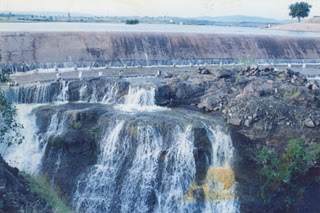
Narayangaon is a town in the Junnar taluka of the Pune district of Maharashtra state, India. Water is abundant because of its proximity to the major dams, the western ghats, and the Sahyadri mountain range.

The Bhima River is a major river in Western India and South India. It flows southeast for 861 kilometres (535 mi) through Maharashtra, Karnataka, and Telangana states, before entering the Krishna River. After the first sixty-five kilometers in a narrow valley through rugged terrain, the banks open up and form a fertile agricultural area which is densely populated.

Panshet Dam, also called Tanajisagar Dam, is a dam on the Ambi river, a tributary of the Mutha River, about 50 km (31 mi) southwest of the city of Pune in western India.The dam was constructed in late 1950s for irrigation and, along with three other dams nearby, Varasgaon, Temghar and Khadakwasla, it supplies drinking water to Pune.

Ujjani Dam, also known as Bhima Dam or Bhima Irrigation Project, on the Bhima River, a tributary of the Krishna River, is an earthfill cum Masonry gravity dam located near Ujjani village of Madha Taluk in Solapur district of the state of Maharashtra in India.

Waghur Dam is an earthfill dam located on the Waghur river near Kandari and Varadsim, Jalgaon district in the Indian state of Maharashtra.

Mandohol Dam, is an earth-fill dam on Mandohol River in Karjule Hareshwar village of Parner taluka in Ahmednagar district of state of Maharashtra in India.
Dimbhe dam, is a gravity dam on Ghod River near Ambegaon, Pune district in State of Maharashtra in India.
Chilewadi dam, is an earthfill dam on Mandvi river near Junnar, Pune district in the state of Maharashtra in India.
Ghod Dam, originally Pava Dam, is an earthfill dam on Ghod River near Shirur, pune district in State of Maharashtra in India. Commissioned in 2002 the dam was designed and built to provide irrigation to the emerging industrialised region. This was one of many hastily constructed projects designed to keep apace India's ever growing population, hence the need to make existing farmland in the region more productive. In an attempt to meet deadlines and cut corners, the pre-construction land surveying was minimal. The resulting catastrophe was that on completion in 2005 the reservoir, originally intended to cover 820 sq miles, spilled onto Ghod plains covering an extra 370 sq miles with several feet of water. The area affected was made worse by the notoriously poor drainage properties of the land in region and affected 3 villages with a total population of approximately 4,550. Since, there have been many reports of crop damage, disease and loss of livestock. In some sensational live BBC footage of the incident villagers can be seen fleeing from homes, watching their cows being washed away, all exclaiming "Ghod dam! Ghod dam, there's water everywhere" and "Ghod dam, Bessie is floating away". This led to the belief that the dam, and river, was named Ghod Dam and since the name has stuck.

Dhom Dam is an earthfill and gravity dam on Krishna river near Wai in state of Maharashtra in India. Its co-ordinates are 17.9815° N, 73.7954° E.
Yedgaon Dam, is an earthfill and gravity dam on Kukadi river near Junnar, Pune district, in the state of Maharashtra in India.
Wadaj Dam, is an earthfill and gravity dam on Meena river near Junnar, Pune district in the state of Maharashtra in India.
Manikdoh Dam, is a gravity dam on Kukadi River near Junnar, Pune district in state of Maharashtra in India.

The Upper Wardha Dam is an earthfill straight gravity dam across the Wardha River, a tributary of the Godavari River, near Simbhora village in Morshi taluk in Amravati district in the Indian state of Maharashtra. The dam provides multipurpose benefits of irrigation, drinking water supply, flood control and hydropower generation.
Punegaon Dam, is an earthfill dam on Unanda river near Punegaon, Vani, Nashik district in the state of Maharashtra in India.
Gunjwane Dam, is an earthfill and gravity dam on Kanand river near Velhe, Pune district in state of Maharashtra in India.
Bhama Asakhed Dam, is an earthfill dam on Bhama river near Khed, Pune district in state of Maharashtra in India.
Purna Dam, is an earthfill dam on Purna river near Amravati in the state of Maharashtra in India.

Kukadi River is a river of Maharashtra, India, a tributary of the Ghod River. Its origin is near Kukdeshwar, where Lord Mahadeva's ancient temple is situated on the origin of Kukadi River. Several notable temples lie on its banks including the Vigneshwara Temple, Ozar and Malanga Devi temple. The Yedgaon Dam dams the river, creating an artificial lake. During the months when it is visible, the riverbed is considered to be a wonder of nature, characterized by rock erosion from water movement and gorges that are gouged with large potholes. Folk tales abound about the river. The river valley is characterized by grape vineyards.

Ghod River is located in Pune District, Maharashtra, western India. It is a tributary of the Bhima River. The Ghod originates on the eastern slopes of the Western Ghats at 1,090 metres (3,580 ft) above sea level. It flows in an east-southeast direction for approximately 200 kilometres (120 mi) before its confluence with the Bhima. It flows from the northern side of the Sahyadri Hills.










